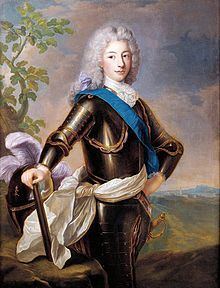Religion Roman Catholicism | ||
 | ||
Born 13 August 1717Paris, France ( 1717-08-13 ) Issue X de BourbonLouis François Joseph de Bourbon Spouse Louise Diane d'Orléans (m. 1731) Children Louis François Joseph, Prince of Conti, Marie François Félix Parents Louis Armand II, Prince of Conti, Louise Élisabeth de Bourbon Grandparents François Louis, Prince of Conti Similar Louis François Joseph - P, Louis Armand II - Prince of, Louise Diane d'Orléans, François Louis - Prince of, Louise Élisabeth de Bourb | ||
Louis François de Bourbon, Prince of Conti (13 August 1717 – 2 August 1776) was a French nobleman, who was the Prince of Conti from 1727 to his death, following his father Louis Armand II. His mother was Louise Élisabeth de Bourbon, a natural granddaughter of Louis XIV. As a member of the reigning House of Bourbon, he was a Prince du Sang.
Contents
Biography
Louis François I de Bourbon was born in Paris.
In 1731, he married his cousin, Louise Diane d'Orléans, Mademoiselle de Chartres, the youngest daughter of Philippe d'Orléans, the Régent of France during the minority of King Louis XV of France, and his wife Françoise-Marie de Bourbon, Mademoiselle de Blois (daughter of Madame de Montespan).
His marriage was organised by his mother the Dowager Princess of Conti and future mother in law the Dowager Duchess of Orléans.
She died in childbirth at the Château d'Issy in 1736. His younger sister, Louise Henriette de Bourbon was the mother of Philippe Égalité. He then stayed at L'Isle-Adam.
Louis François pursued a military career, and when the War of the Austrian Succession broke out in 1741, he accompanied the Duke of Belle-Isle to Bohemia. His services there led to his command of the army in Italy, where he distinguished himself by forcing the pass of Villafranca and winning the battle of Coni in 1744.
In 1745 he was sent to check the Austrians in Germany. In 1746, he was transferred to the Netherlands, where conflicts with the Maréchal de Saxe led to his retirement in 1747 to the Château de L'Isle-Adam.
In 1760 he bought a famous Burgundy vineyard which at that time bore the name of La Romanée, at a high price. After the purchase he added his own name to the vineyard, which since has been known as Romanée-Conti. The wine from this vineyard is one of the world's most expensive.
Candidate to the Polish Throne
In that same year, a faction of Polish nobles offered Conti the throne of Poland, where King Augustus III was expected to die soon. Conti was able to win the personal support of Louis XV of France for his candidacy. However, the policy of the king's ministers was to establish the ruling house of Saxony upon the throne in Poland, as Louis XV's daughter-in-law, Marie-Josèphe of Saxony, was a daughter of the ailing Augustus. As a result of this conflict, Louis XV began secret communications with his ambassadors at certain influential foreign courts that were in direct opposition to the official communications being sent to those same ambassadors by his ministers. The system of couriers used to relay the king's secret messages developed later into a spy-network known as the Secret du Roi.
Although Conti did not secure the Polish throne, he did remain in the confidence of the king until 1755, when his influence was destroyed by the intrigues of the king's mistress, Madame de Pompadour. His relationship with Louis XV deteriorated so, that when the Seven Years' War broke out in 1756, Conti was refused the command of the army of the Rhine. Angry, he began opposing the royal government, which caused Louis to refer to him as, "my cousin, the advocate".
In 1771, Conti took the lead in opposing the chancellor, Maupeou. He supported the parlements against the government and was especially hostile to Turgot. Due to the intensity of his anti-government feelings, he was suspected of aiding an uprising which took place in Dijon in 1775.
He was exiled from court, and following involvement in a Frondiste association with Protestants and with the affairs of Parlement, Conti settled into stylish retirement as Grand Prior of the Knights of the Order of Malta, resident at the Palais du Temple in Le Marais.
Conti went on to accumulate a vast and celebrated art collection, housed in a special gallery at the Temple, mostly collected during the last twenty years of his life. This was dispersed by auction between April and June 1777, a sale which retained an impact on the Parisian art market through the following decade. His collection included Michel Barthélemy Ollivier's English Tea Served in the Salon des Glaces at the Palais du Temple, dated 1764, showing the infant Mozart at the clavichord (now in the Palace of Versailles).
Conti inherited literary tastes from his father, was a brave and skillful general, and a diligent student of military history. His mistress, the cultivated Comtesse de Boufflers (1725–1800), presided over a salon at his home in Paris, which attracted many men of letters. Through his mistress, he became a patron of Jean Jacques Rousseau.
He was succeeded by his son, Louis François Joseph (1734–1814), who was the last person to bear the Conti title.
